Leadership and Management: M&S Case Study Analysis and Report
VerifiedAdded on 2020/02/17
|14
|4159
|47
Report
AI Summary
This report provides a comprehensive analysis of leadership and management practices within Marks & Spencer (M&S), focusing on the company's operational strategies and challenges. The report begins by defining the roles and characteristics of leaders and managers within M&S, differentiating between their functions and responsibilities, and examining how their approaches vary in different situational contexts. It then delves into various leadership and management theories, including traditional and modern approaches like trait theory, contingency theory, transformational leadership, and systems theory, and how these theories apply to M&S's specific scenario of a sales slowdown. The report further explores key approaches to operations management, emphasizing the importance of operational efficiency and effectiveness in achieving business objectives, and identifies factors that impact operational management and decision-making within the organization. The report concludes with a detailed examination of how M&S leaders and managers have responded to challenges and opportunities, offering insights into strategic leadership, employee engagement, and performance management within the context of the retail giant's operations.
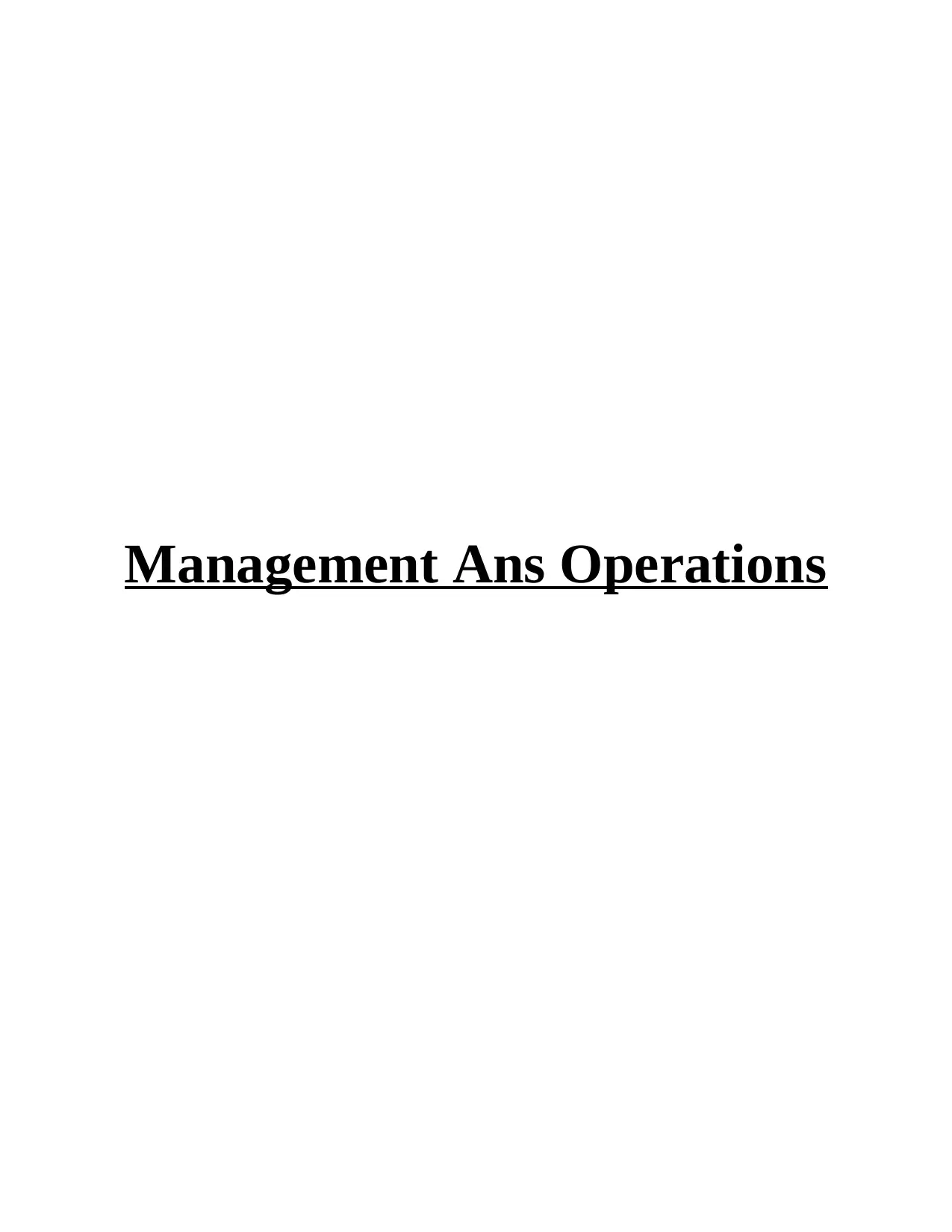
Management Ans Operations
Paraphrase This Document
Need a fresh take? Get an instant paraphrase of this document with our AI Paraphraser
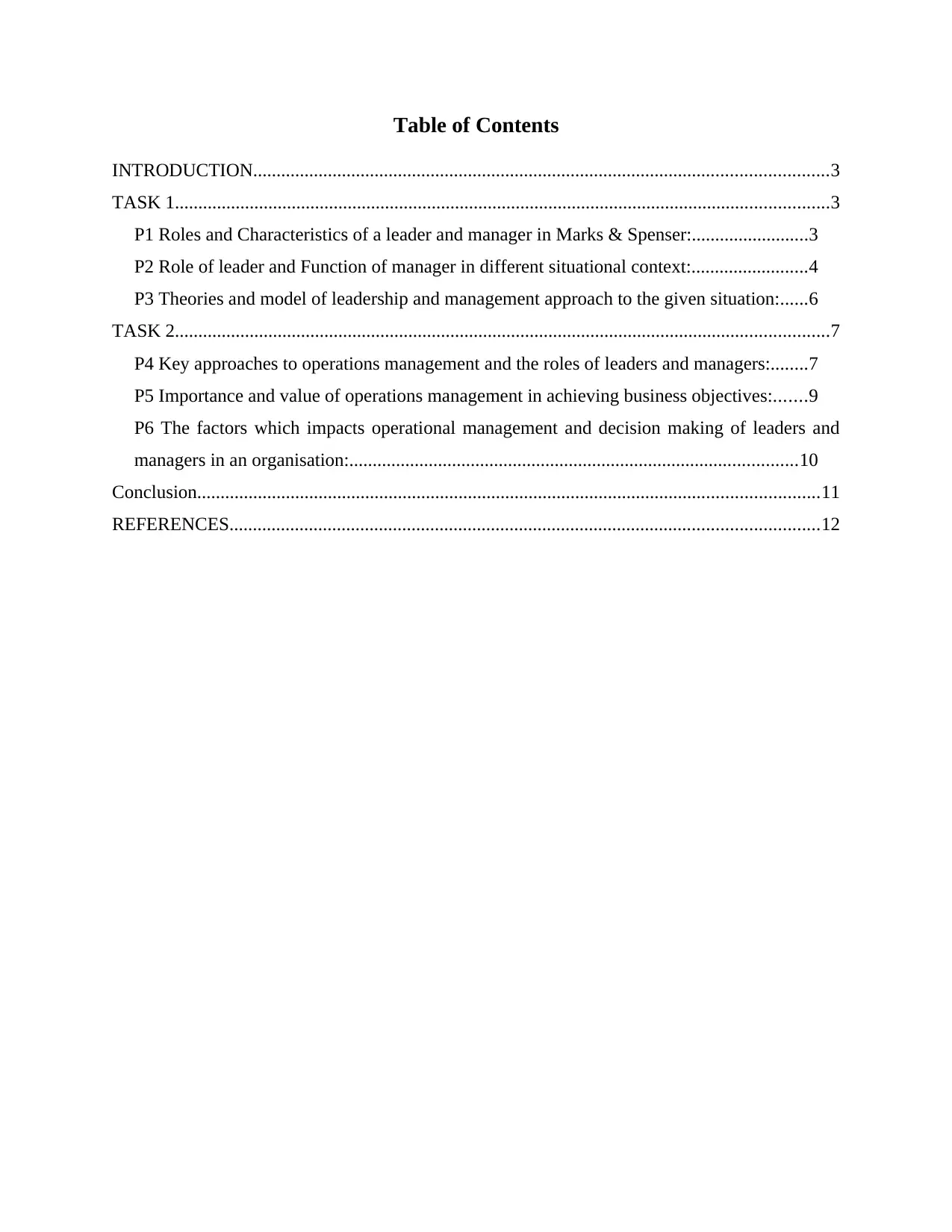
Table of Contents
INTRODUCTION...........................................................................................................................3
TASK 1............................................................................................................................................3
P1 Roles and Characteristics of a leader and manager in Marks & Spenser:.........................3
P2 Role of leader and Function of manager in different situational context:.........................4
P3 Theories and model of leadership and management approach to the given situation:......6
TASK 2............................................................................................................................................7
P4 Key approaches to operations management and the roles of leaders and managers:........7
P5 Importance and value of operations management in achieving business objectives:.......9
P6 The factors which impacts operational management and decision making of leaders and
managers in an organisation:................................................................................................10
Conclusion.....................................................................................................................................11
REFERENCES..............................................................................................................................12
INTRODUCTION...........................................................................................................................3
TASK 1............................................................................................................................................3
P1 Roles and Characteristics of a leader and manager in Marks & Spenser:.........................3
P2 Role of leader and Function of manager in different situational context:.........................4
P3 Theories and model of leadership and management approach to the given situation:......6
TASK 2............................................................................................................................................7
P4 Key approaches to operations management and the roles of leaders and managers:........7
P5 Importance and value of operations management in achieving business objectives:.......9
P6 The factors which impacts operational management and decision making of leaders and
managers in an organisation:................................................................................................10
Conclusion.....................................................................................................................................11
REFERENCES..............................................................................................................................12
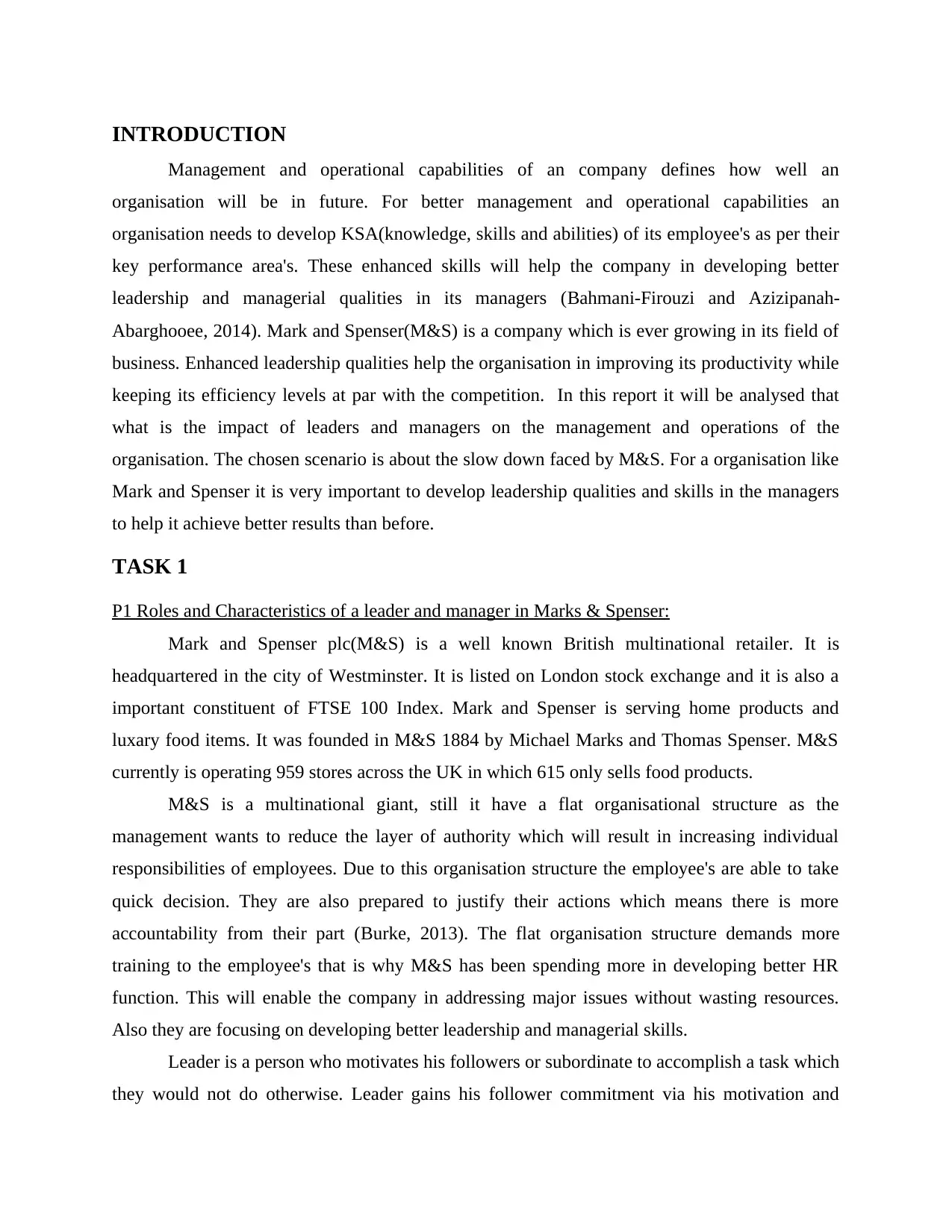
INTRODUCTION
Management and operational capabilities of an company defines how well an
organisation will be in future. For better management and operational capabilities an
organisation needs to develop KSA(knowledge, skills and abilities) of its employee's as per their
key performance area's. These enhanced skills will help the company in developing better
leadership and managerial qualities in its managers (Bahmani-Firouzi and Azizipanah-
Abarghooee, 2014). Mark and Spenser(M&S) is a company which is ever growing in its field of
business. Enhanced leadership qualities help the organisation in improving its productivity while
keeping its efficiency levels at par with the competition. In this report it will be analysed that
what is the impact of leaders and managers on the management and operations of the
organisation. The chosen scenario is about the slow down faced by M&S. For a organisation like
Mark and Spenser it is very important to develop leadership qualities and skills in the managers
to help it achieve better results than before.
TASK 1
P1 Roles and Characteristics of a leader and manager in Marks & Spenser:
Mark and Spenser plc(M&S) is a well known British multinational retailer. It is
headquartered in the city of Westminster. It is listed on London stock exchange and it is also a
important constituent of FTSE 100 Index. Mark and Spenser is serving home products and
luxary food items. It was founded in M&S 1884 by Michael Marks and Thomas Spenser. M&S
currently is operating 959 stores across the UK in which 615 only sells food products.
M&S is a multinational giant, still it have a flat organisational structure as the
management wants to reduce the layer of authority which will result in increasing individual
responsibilities of employees. Due to this organisation structure the employee's are able to take
quick decision. They are also prepared to justify their actions which means there is more
accountability from their part (Burke, 2013). The flat organisation structure demands more
training to the employee's that is why M&S has been spending more in developing better HR
function. This will enable the company in addressing major issues without wasting resources.
Also they are focusing on developing better leadership and managerial skills.
Leader is a person who motivates his followers or subordinate to accomplish a task which
they would not do otherwise. Leader gains his follower commitment via his motivation and
Management and operational capabilities of an company defines how well an
organisation will be in future. For better management and operational capabilities an
organisation needs to develop KSA(knowledge, skills and abilities) of its employee's as per their
key performance area's. These enhanced skills will help the company in developing better
leadership and managerial qualities in its managers (Bahmani-Firouzi and Azizipanah-
Abarghooee, 2014). Mark and Spenser(M&S) is a company which is ever growing in its field of
business. Enhanced leadership qualities help the organisation in improving its productivity while
keeping its efficiency levels at par with the competition. In this report it will be analysed that
what is the impact of leaders and managers on the management and operations of the
organisation. The chosen scenario is about the slow down faced by M&S. For a organisation like
Mark and Spenser it is very important to develop leadership qualities and skills in the managers
to help it achieve better results than before.
TASK 1
P1 Roles and Characteristics of a leader and manager in Marks & Spenser:
Mark and Spenser plc(M&S) is a well known British multinational retailer. It is
headquartered in the city of Westminster. It is listed on London stock exchange and it is also a
important constituent of FTSE 100 Index. Mark and Spenser is serving home products and
luxary food items. It was founded in M&S 1884 by Michael Marks and Thomas Spenser. M&S
currently is operating 959 stores across the UK in which 615 only sells food products.
M&S is a multinational giant, still it have a flat organisational structure as the
management wants to reduce the layer of authority which will result in increasing individual
responsibilities of employees. Due to this organisation structure the employee's are able to take
quick decision. They are also prepared to justify their actions which means there is more
accountability from their part (Burke, 2013). The flat organisation structure demands more
training to the employee's that is why M&S has been spending more in developing better HR
function. This will enable the company in addressing major issues without wasting resources.
Also they are focusing on developing better leadership and managerial skills.
Leader is a person who motivates his followers or subordinate to accomplish a task which
they would not do otherwise. Leader gains his follower commitment via his motivation and
⊘ This is a preview!⊘
Do you want full access?
Subscribe today to unlock all pages.

Trusted by 1+ million students worldwide
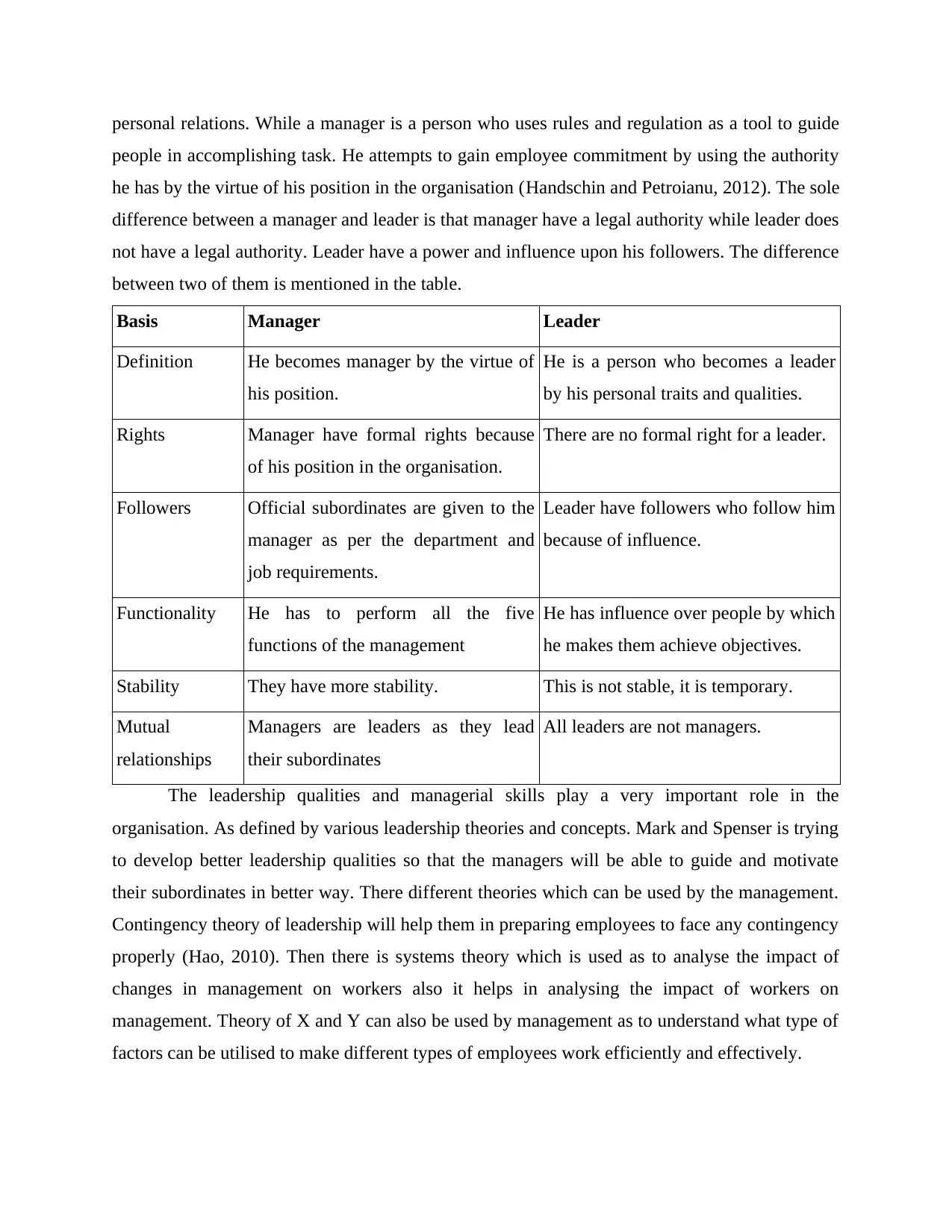
personal relations. While a manager is a person who uses rules and regulation as a tool to guide
people in accomplishing task. He attempts to gain employee commitment by using the authority
he has by the virtue of his position in the organisation (Handschin and Petroianu, 2012). The sole
difference between a manager and leader is that manager have a legal authority while leader does
not have a legal authority. Leader have a power and influence upon his followers. The difference
between two of them is mentioned in the table.
Basis Manager Leader
Definition He becomes manager by the virtue of
his position.
He is a person who becomes a leader
by his personal traits and qualities.
Rights Manager have formal rights because
of his position in the organisation.
There are no formal right for a leader.
Followers Official subordinates are given to the
manager as per the department and
job requirements.
Leader have followers who follow him
because of influence.
Functionality He has to perform all the five
functions of the management
He has influence over people by which
he makes them achieve objectives.
Stability They have more stability. This is not stable, it is temporary.
Mutual
relationships
Managers are leaders as they lead
their subordinates
All leaders are not managers.
The leadership qualities and managerial skills play a very important role in the
organisation. As defined by various leadership theories and concepts. Mark and Spenser is trying
to develop better leadership qualities so that the managers will be able to guide and motivate
their subordinates in better way. There different theories which can be used by the management.
Contingency theory of leadership will help them in preparing employees to face any contingency
properly (Hao, 2010). Then there is systems theory which is used as to analyse the impact of
changes in management on workers also it helps in analysing the impact of workers on
management. Theory of X and Y can also be used by management as to understand what type of
factors can be utilised to make different types of employees work efficiently and effectively.
people in accomplishing task. He attempts to gain employee commitment by using the authority
he has by the virtue of his position in the organisation (Handschin and Petroianu, 2012). The sole
difference between a manager and leader is that manager have a legal authority while leader does
not have a legal authority. Leader have a power and influence upon his followers. The difference
between two of them is mentioned in the table.
Basis Manager Leader
Definition He becomes manager by the virtue of
his position.
He is a person who becomes a leader
by his personal traits and qualities.
Rights Manager have formal rights because
of his position in the organisation.
There are no formal right for a leader.
Followers Official subordinates are given to the
manager as per the department and
job requirements.
Leader have followers who follow him
because of influence.
Functionality He has to perform all the five
functions of the management
He has influence over people by which
he makes them achieve objectives.
Stability They have more stability. This is not stable, it is temporary.
Mutual
relationships
Managers are leaders as they lead
their subordinates
All leaders are not managers.
The leadership qualities and managerial skills play a very important role in the
organisation. As defined by various leadership theories and concepts. Mark and Spenser is trying
to develop better leadership qualities so that the managers will be able to guide and motivate
their subordinates in better way. There different theories which can be used by the management.
Contingency theory of leadership will help them in preparing employees to face any contingency
properly (Hao, 2010). Then there is systems theory which is used as to analyse the impact of
changes in management on workers also it helps in analysing the impact of workers on
management. Theory of X and Y can also be used by management as to understand what type of
factors can be utilised to make different types of employees work efficiently and effectively.
Paraphrase This Document
Need a fresh take? Get an instant paraphrase of this document with our AI Paraphraser
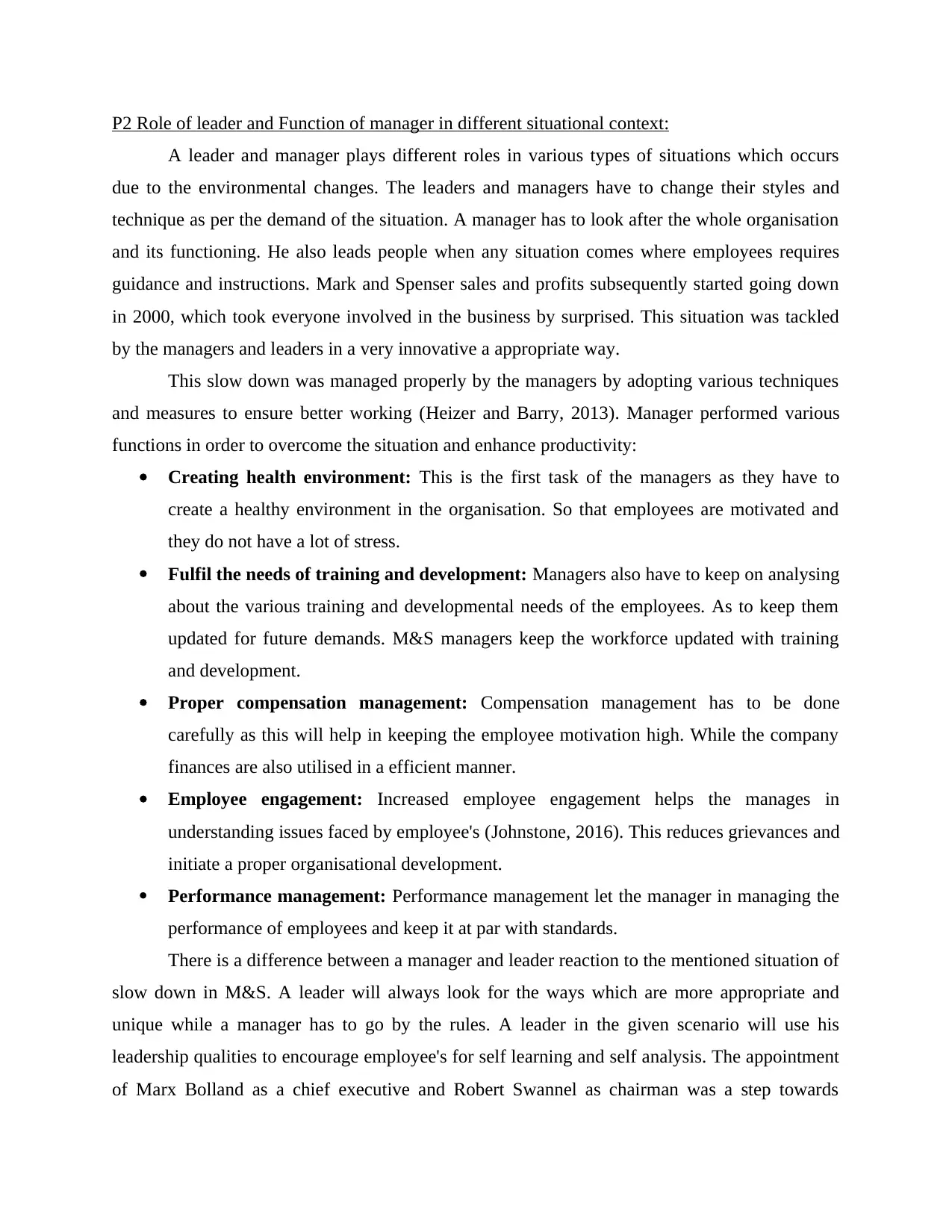
P2 Role of leader and Function of manager in different situational context:
A leader and manager plays different roles in various types of situations which occurs
due to the environmental changes. The leaders and managers have to change their styles and
technique as per the demand of the situation. A manager has to look after the whole organisation
and its functioning. He also leads people when any situation comes where employees requires
guidance and instructions. Mark and Spenser sales and profits subsequently started going down
in 2000, which took everyone involved in the business by surprised. This situation was tackled
by the managers and leaders in a very innovative a appropriate way.
This slow down was managed properly by the managers by adopting various techniques
and measures to ensure better working (Heizer and Barry, 2013). Manager performed various
functions in order to overcome the situation and enhance productivity:
Creating health environment: This is the first task of the managers as they have to
create a healthy environment in the organisation. So that employees are motivated and
they do not have a lot of stress.
Fulfil the needs of training and development: Managers also have to keep on analysing
about the various training and developmental needs of the employees. As to keep them
updated for future demands. M&S managers keep the workforce updated with training
and development.
Proper compensation management: Compensation management has to be done
carefully as this will help in keeping the employee motivation high. While the company
finances are also utilised in a efficient manner.
Employee engagement: Increased employee engagement helps the manages in
understanding issues faced by employee's (Johnstone, 2016). This reduces grievances and
initiate a proper organisational development.
Performance management: Performance management let the manager in managing the
performance of employees and keep it at par with standards.
There is a difference between a manager and leader reaction to the mentioned situation of
slow down in M&S. A leader will always look for the ways which are more appropriate and
unique while a manager has to go by the rules. A leader in the given scenario will use his
leadership qualities to encourage employee's for self learning and self analysis. The appointment
of Marx Bolland as a chief executive and Robert Swannel as chairman was a step towards
A leader and manager plays different roles in various types of situations which occurs
due to the environmental changes. The leaders and managers have to change their styles and
technique as per the demand of the situation. A manager has to look after the whole organisation
and its functioning. He also leads people when any situation comes where employees requires
guidance and instructions. Mark and Spenser sales and profits subsequently started going down
in 2000, which took everyone involved in the business by surprised. This situation was tackled
by the managers and leaders in a very innovative a appropriate way.
This slow down was managed properly by the managers by adopting various techniques
and measures to ensure better working (Heizer and Barry, 2013). Manager performed various
functions in order to overcome the situation and enhance productivity:
Creating health environment: This is the first task of the managers as they have to
create a healthy environment in the organisation. So that employees are motivated and
they do not have a lot of stress.
Fulfil the needs of training and development: Managers also have to keep on analysing
about the various training and developmental needs of the employees. As to keep them
updated for future demands. M&S managers keep the workforce updated with training
and development.
Proper compensation management: Compensation management has to be done
carefully as this will help in keeping the employee motivation high. While the company
finances are also utilised in a efficient manner.
Employee engagement: Increased employee engagement helps the manages in
understanding issues faced by employee's (Johnstone, 2016). This reduces grievances and
initiate a proper organisational development.
Performance management: Performance management let the manager in managing the
performance of employees and keep it at par with standards.
There is a difference between a manager and leader reaction to the mentioned situation of
slow down in M&S. A leader will always look for the ways which are more appropriate and
unique while a manager has to go by the rules. A leader in the given scenario will use his
leadership qualities to encourage employee's for self learning and self analysis. The appointment
of Marx Bolland as a chief executive and Robert Swannel as chairman was a step towards
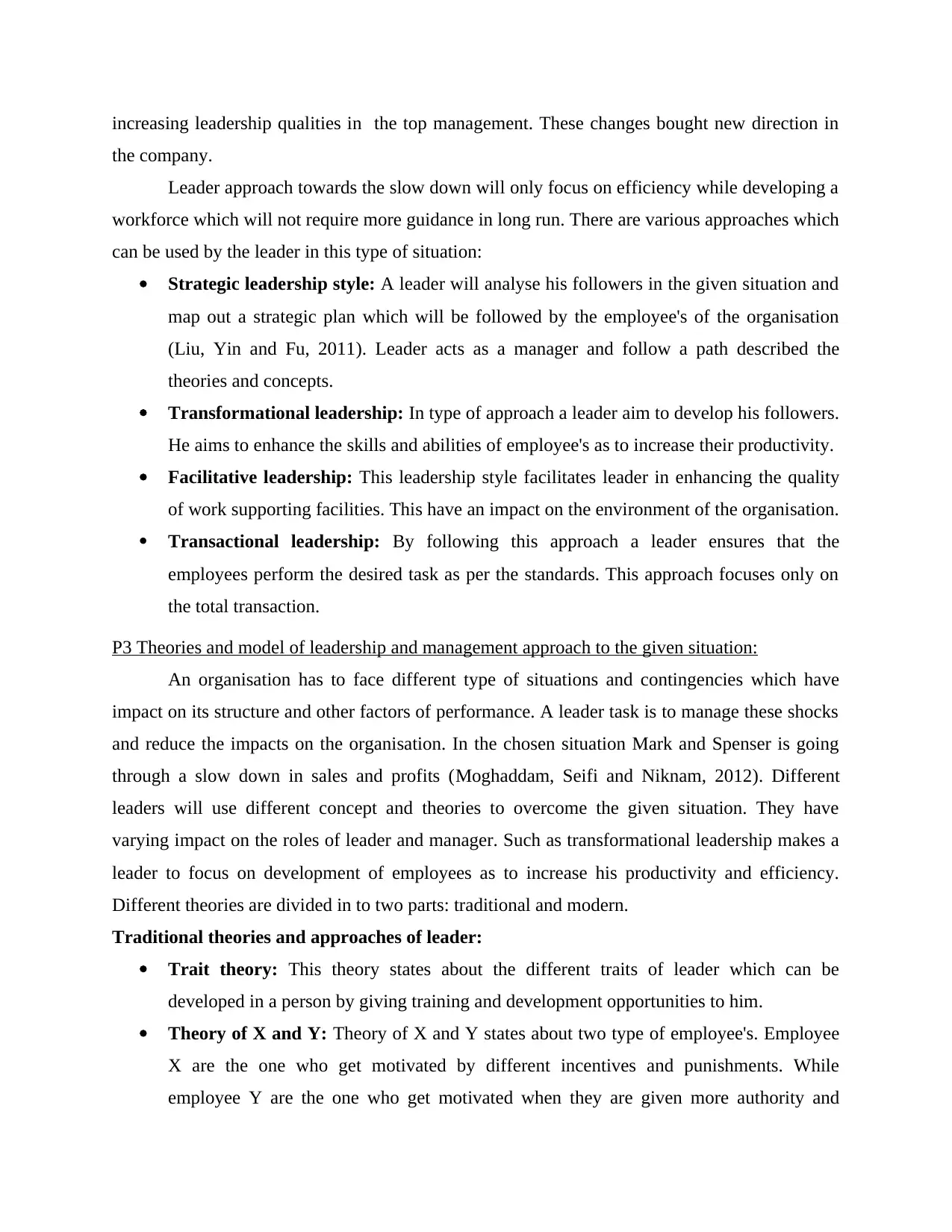
increasing leadership qualities in the top management. These changes bought new direction in
the company.
Leader approach towards the slow down will only focus on efficiency while developing a
workforce which will not require more guidance in long run. There are various approaches which
can be used by the leader in this type of situation:
Strategic leadership style: A leader will analyse his followers in the given situation and
map out a strategic plan which will be followed by the employee's of the organisation
(Liu, Yin and Fu, 2011). Leader acts as a manager and follow a path described the
theories and concepts.
Transformational leadership: In type of approach a leader aim to develop his followers.
He aims to enhance the skills and abilities of employee's as to increase their productivity.
Facilitative leadership: This leadership style facilitates leader in enhancing the quality
of work supporting facilities. This have an impact on the environment of the organisation.
Transactional leadership: By following this approach a leader ensures that the
employees perform the desired task as per the standards. This approach focuses only on
the total transaction.
P3 Theories and model of leadership and management approach to the given situation:
An organisation has to face different type of situations and contingencies which have
impact on its structure and other factors of performance. A leader task is to manage these shocks
and reduce the impacts on the organisation. In the chosen situation Mark and Spenser is going
through a slow down in sales and profits (Moghaddam, Seifi and Niknam, 2012). Different
leaders will use different concept and theories to overcome the given situation. They have
varying impact on the roles of leader and manager. Such as transformational leadership makes a
leader to focus on development of employees as to increase his productivity and efficiency.
Different theories are divided in to two parts: traditional and modern.
Traditional theories and approaches of leader:
Trait theory: This theory states about the different traits of leader which can be
developed in a person by giving training and development opportunities to him.
Theory of X and Y: Theory of X and Y states about two type of employee's. Employee
X are the one who get motivated by different incentives and punishments. While
employee Y are the one who get motivated when they are given more authority and
the company.
Leader approach towards the slow down will only focus on efficiency while developing a
workforce which will not require more guidance in long run. There are various approaches which
can be used by the leader in this type of situation:
Strategic leadership style: A leader will analyse his followers in the given situation and
map out a strategic plan which will be followed by the employee's of the organisation
(Liu, Yin and Fu, 2011). Leader acts as a manager and follow a path described the
theories and concepts.
Transformational leadership: In type of approach a leader aim to develop his followers.
He aims to enhance the skills and abilities of employee's as to increase their productivity.
Facilitative leadership: This leadership style facilitates leader in enhancing the quality
of work supporting facilities. This have an impact on the environment of the organisation.
Transactional leadership: By following this approach a leader ensures that the
employees perform the desired task as per the standards. This approach focuses only on
the total transaction.
P3 Theories and model of leadership and management approach to the given situation:
An organisation has to face different type of situations and contingencies which have
impact on its structure and other factors of performance. A leader task is to manage these shocks
and reduce the impacts on the organisation. In the chosen situation Mark and Spenser is going
through a slow down in sales and profits (Moghaddam, Seifi and Niknam, 2012). Different
leaders will use different concept and theories to overcome the given situation. They have
varying impact on the roles of leader and manager. Such as transformational leadership makes a
leader to focus on development of employees as to increase his productivity and efficiency.
Different theories are divided in to two parts: traditional and modern.
Traditional theories and approaches of leader:
Trait theory: This theory states about the different traits of leader which can be
developed in a person by giving training and development opportunities to him.
Theory of X and Y: Theory of X and Y states about two type of employee's. Employee
X are the one who get motivated by different incentives and punishments. While
employee Y are the one who get motivated when they are given more authority and
⊘ This is a preview!⊘
Do you want full access?
Subscribe today to unlock all pages.

Trusted by 1+ million students worldwide
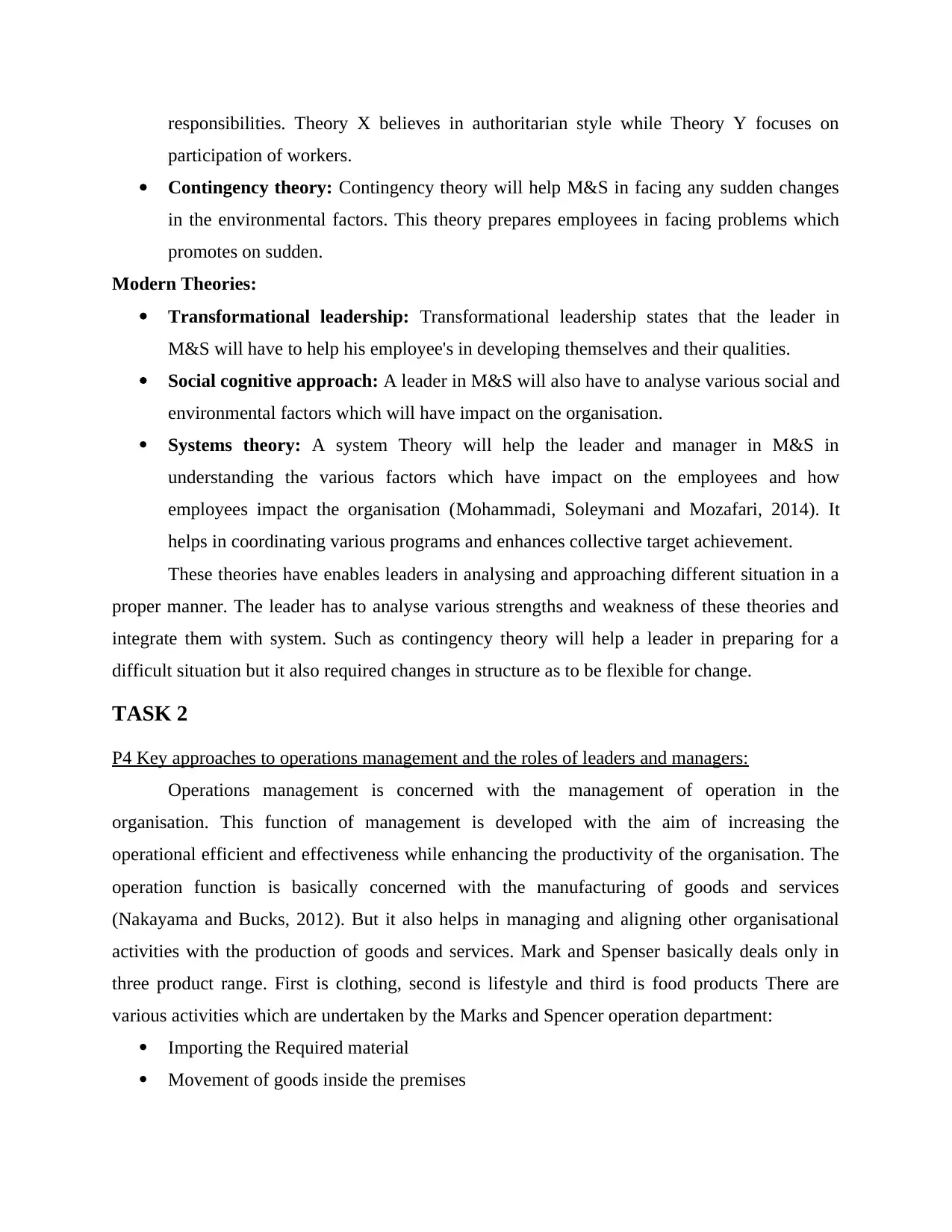
responsibilities. Theory X believes in authoritarian style while Theory Y focuses on
participation of workers.
Contingency theory: Contingency theory will help M&S in facing any sudden changes
in the environmental factors. This theory prepares employees in facing problems which
promotes on sudden.
Modern Theories:
Transformational leadership: Transformational leadership states that the leader in
M&S will have to help his employee's in developing themselves and their qualities.
Social cognitive approach: A leader in M&S will also have to analyse various social and
environmental factors which will have impact on the organisation.
Systems theory: A system Theory will help the leader and manager in M&S in
understanding the various factors which have impact on the employees and how
employees impact the organisation (Mohammadi, Soleymani and Mozafari, 2014). It
helps in coordinating various programs and enhances collective target achievement.
These theories have enables leaders in analysing and approaching different situation in a
proper manner. The leader has to analyse various strengths and weakness of these theories and
integrate them with system. Such as contingency theory will help a leader in preparing for a
difficult situation but it also required changes in structure as to be flexible for change.
TASK 2
P4 Key approaches to operations management and the roles of leaders and managers:
Operations management is concerned with the management of operation in the
organisation. This function of management is developed with the aim of increasing the
operational efficient and effectiveness while enhancing the productivity of the organisation. The
operation function is basically concerned with the manufacturing of goods and services
(Nakayama and Bucks, 2012). But it also helps in managing and aligning other organisational
activities with the production of goods and services. Mark and Spenser basically deals only in
three product range. First is clothing, second is lifestyle and third is food products There are
various activities which are undertaken by the Marks and Spencer operation department:
Importing the Required material
Movement of goods inside the premises
participation of workers.
Contingency theory: Contingency theory will help M&S in facing any sudden changes
in the environmental factors. This theory prepares employees in facing problems which
promotes on sudden.
Modern Theories:
Transformational leadership: Transformational leadership states that the leader in
M&S will have to help his employee's in developing themselves and their qualities.
Social cognitive approach: A leader in M&S will also have to analyse various social and
environmental factors which will have impact on the organisation.
Systems theory: A system Theory will help the leader and manager in M&S in
understanding the various factors which have impact on the employees and how
employees impact the organisation (Mohammadi, Soleymani and Mozafari, 2014). It
helps in coordinating various programs and enhances collective target achievement.
These theories have enables leaders in analysing and approaching different situation in a
proper manner. The leader has to analyse various strengths and weakness of these theories and
integrate them with system. Such as contingency theory will help a leader in preparing for a
difficult situation but it also required changes in structure as to be flexible for change.
TASK 2
P4 Key approaches to operations management and the roles of leaders and managers:
Operations management is concerned with the management of operation in the
organisation. This function of management is developed with the aim of increasing the
operational efficient and effectiveness while enhancing the productivity of the organisation. The
operation function is basically concerned with the manufacturing of goods and services
(Nakayama and Bucks, 2012). But it also helps in managing and aligning other organisational
activities with the production of goods and services. Mark and Spenser basically deals only in
three product range. First is clothing, second is lifestyle and third is food products There are
various activities which are undertaken by the Marks and Spencer operation department:
Importing the Required material
Movement of goods inside the premises
Paraphrase This Document
Need a fresh take? Get an instant paraphrase of this document with our AI Paraphraser
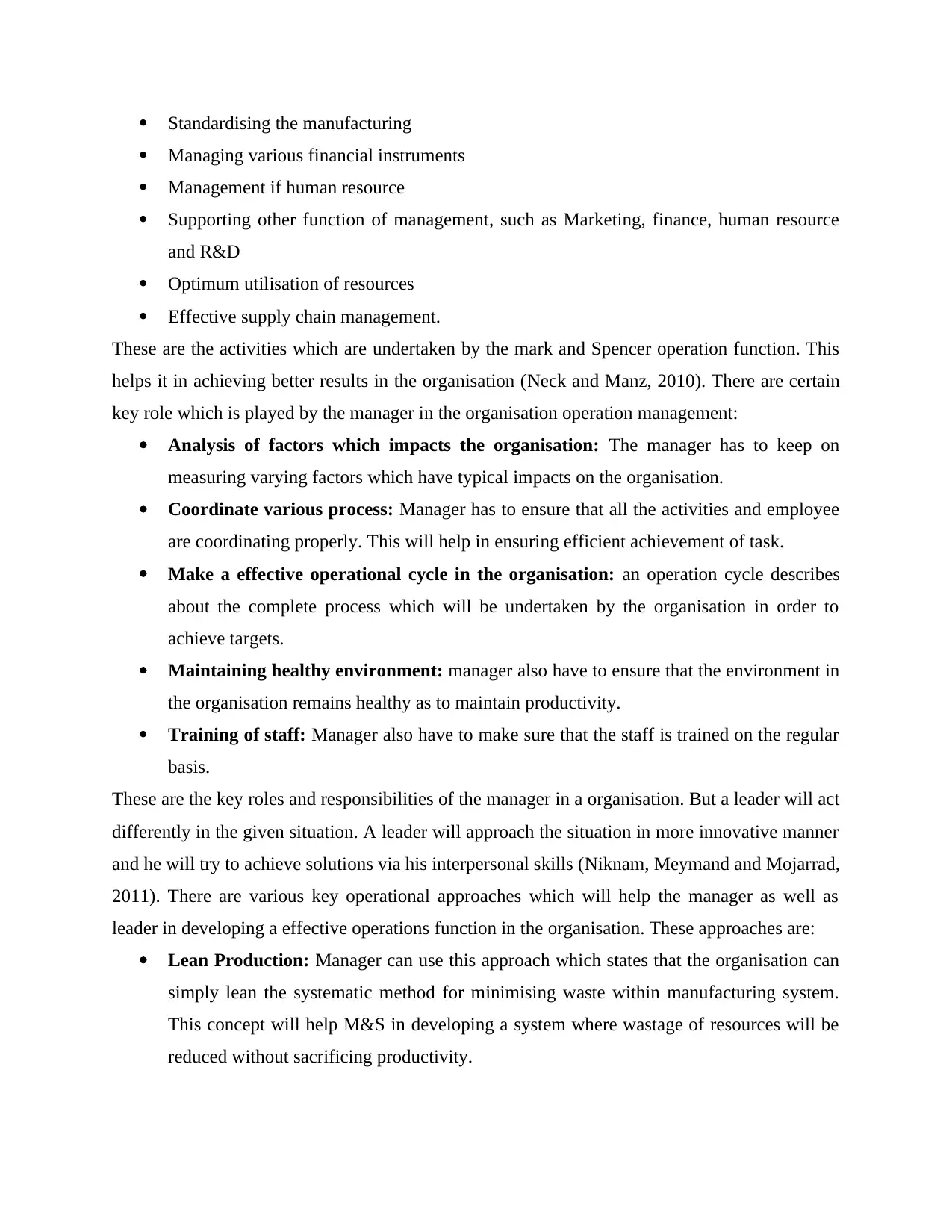
Standardising the manufacturing
Managing various financial instruments
Management if human resource
Supporting other function of management, such as Marketing, finance, human resource
and R&D
Optimum utilisation of resources
Effective supply chain management.
These are the activities which are undertaken by the mark and Spencer operation function. This
helps it in achieving better results in the organisation (Neck and Manz, 2010). There are certain
key role which is played by the manager in the organisation operation management:
Analysis of factors which impacts the organisation: The manager has to keep on
measuring varying factors which have typical impacts on the organisation.
Coordinate various process: Manager has to ensure that all the activities and employee
are coordinating properly. This will help in ensuring efficient achievement of task.
Make a effective operational cycle in the organisation: an operation cycle describes
about the complete process which will be undertaken by the organisation in order to
achieve targets.
Maintaining healthy environment: manager also have to ensure that the environment in
the organisation remains healthy as to maintain productivity.
Training of staff: Manager also have to make sure that the staff is trained on the regular
basis.
These are the key roles and responsibilities of the manager in a organisation. But a leader will act
differently in the given situation. A leader will approach the situation in more innovative manner
and he will try to achieve solutions via his interpersonal skills (Niknam, Meymand and Mojarrad,
2011). There are various key operational approaches which will help the manager as well as
leader in developing a effective operations function in the organisation. These approaches are:
Lean Production: Manager can use this approach which states that the organisation can
simply lean the systematic method for minimising waste within manufacturing system.
This concept will help M&S in developing a system where wastage of resources will be
reduced without sacrificing productivity.
Managing various financial instruments
Management if human resource
Supporting other function of management, such as Marketing, finance, human resource
and R&D
Optimum utilisation of resources
Effective supply chain management.
These are the activities which are undertaken by the mark and Spencer operation function. This
helps it in achieving better results in the organisation (Neck and Manz, 2010). There are certain
key role which is played by the manager in the organisation operation management:
Analysis of factors which impacts the organisation: The manager has to keep on
measuring varying factors which have typical impacts on the organisation.
Coordinate various process: Manager has to ensure that all the activities and employee
are coordinating properly. This will help in ensuring efficient achievement of task.
Make a effective operational cycle in the organisation: an operation cycle describes
about the complete process which will be undertaken by the organisation in order to
achieve targets.
Maintaining healthy environment: manager also have to ensure that the environment in
the organisation remains healthy as to maintain productivity.
Training of staff: Manager also have to make sure that the staff is trained on the regular
basis.
These are the key roles and responsibilities of the manager in a organisation. But a leader will act
differently in the given situation. A leader will approach the situation in more innovative manner
and he will try to achieve solutions via his interpersonal skills (Niknam, Meymand and Mojarrad,
2011). There are various key operational approaches which will help the manager as well as
leader in developing a effective operations function in the organisation. These approaches are:
Lean Production: Manager can use this approach which states that the organisation can
simply lean the systematic method for minimising waste within manufacturing system.
This concept will help M&S in developing a system where wastage of resources will be
reduced without sacrificing productivity.
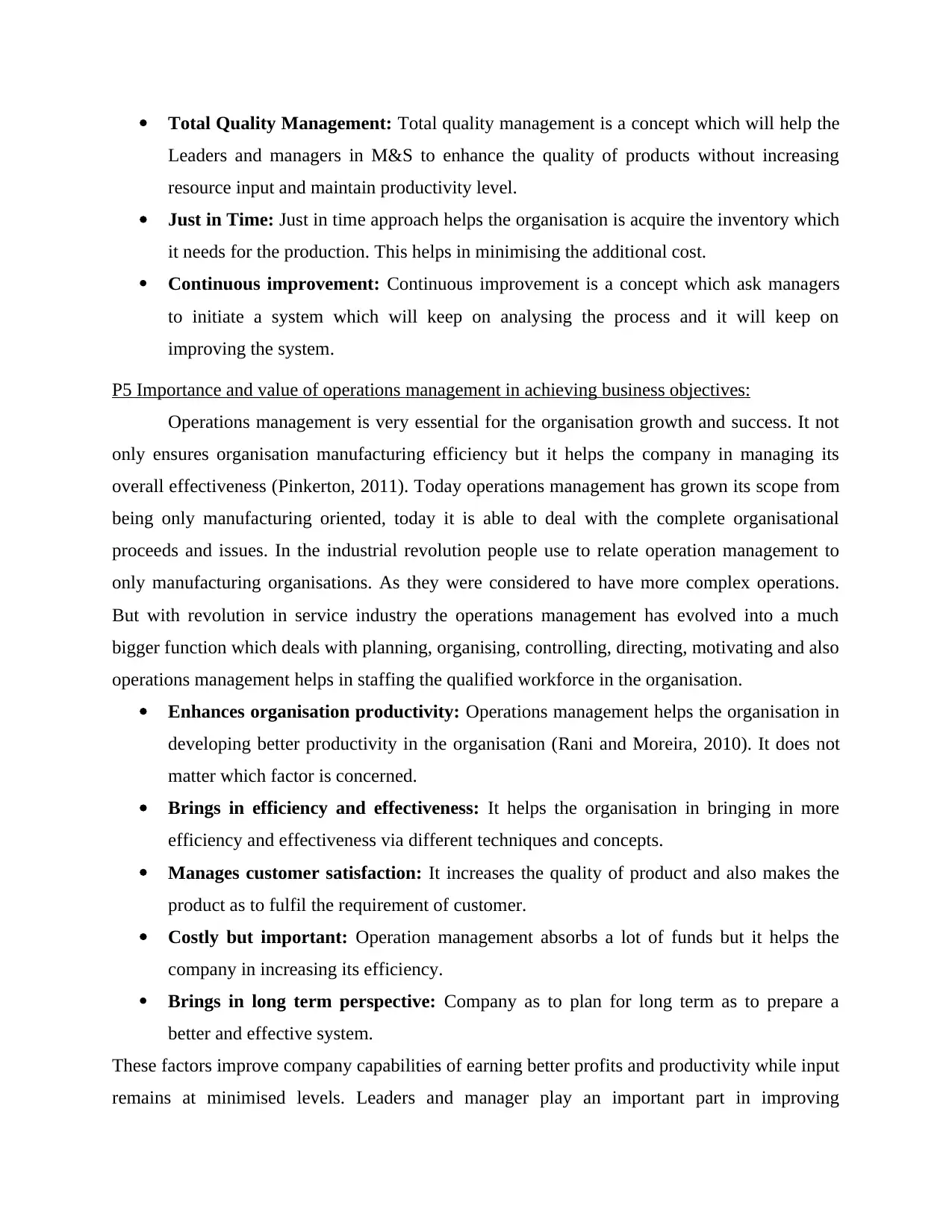
Total Quality Management: Total quality management is a concept which will help the
Leaders and managers in M&S to enhance the quality of products without increasing
resource input and maintain productivity level.
Just in Time: Just in time approach helps the organisation is acquire the inventory which
it needs for the production. This helps in minimising the additional cost.
Continuous improvement: Continuous improvement is a concept which ask managers
to initiate a system which will keep on analysing the process and it will keep on
improving the system.
P5 Importance and value of operations management in achieving business objectives:
Operations management is very essential for the organisation growth and success. It not
only ensures organisation manufacturing efficiency but it helps the company in managing its
overall effectiveness (Pinkerton, 2011). Today operations management has grown its scope from
being only manufacturing oriented, today it is able to deal with the complete organisational
proceeds and issues. In the industrial revolution people use to relate operation management to
only manufacturing organisations. As they were considered to have more complex operations.
But with revolution in service industry the operations management has evolved into a much
bigger function which deals with planning, organising, controlling, directing, motivating and also
operations management helps in staffing the qualified workforce in the organisation.
Enhances organisation productivity: Operations management helps the organisation in
developing better productivity in the organisation (Rani and Moreira, 2010). It does not
matter which factor is concerned.
Brings in efficiency and effectiveness: It helps the organisation in bringing in more
efficiency and effectiveness via different techniques and concepts.
Manages customer satisfaction: It increases the quality of product and also makes the
product as to fulfil the requirement of customer.
Costly but important: Operation management absorbs a lot of funds but it helps the
company in increasing its efficiency.
Brings in long term perspective: Company as to plan for long term as to prepare a
better and effective system.
These factors improve company capabilities of earning better profits and productivity while input
remains at minimised levels. Leaders and manager play an important part in improving
Leaders and managers in M&S to enhance the quality of products without increasing
resource input and maintain productivity level.
Just in Time: Just in time approach helps the organisation is acquire the inventory which
it needs for the production. This helps in minimising the additional cost.
Continuous improvement: Continuous improvement is a concept which ask managers
to initiate a system which will keep on analysing the process and it will keep on
improving the system.
P5 Importance and value of operations management in achieving business objectives:
Operations management is very essential for the organisation growth and success. It not
only ensures organisation manufacturing efficiency but it helps the company in managing its
overall effectiveness (Pinkerton, 2011). Today operations management has grown its scope from
being only manufacturing oriented, today it is able to deal with the complete organisational
proceeds and issues. In the industrial revolution people use to relate operation management to
only manufacturing organisations. As they were considered to have more complex operations.
But with revolution in service industry the operations management has evolved into a much
bigger function which deals with planning, organising, controlling, directing, motivating and also
operations management helps in staffing the qualified workforce in the organisation.
Enhances organisation productivity: Operations management helps the organisation in
developing better productivity in the organisation (Rani and Moreira, 2010). It does not
matter which factor is concerned.
Brings in efficiency and effectiveness: It helps the organisation in bringing in more
efficiency and effectiveness via different techniques and concepts.
Manages customer satisfaction: It increases the quality of product and also makes the
product as to fulfil the requirement of customer.
Costly but important: Operation management absorbs a lot of funds but it helps the
company in increasing its efficiency.
Brings in long term perspective: Company as to plan for long term as to prepare a
better and effective system.
These factors improve company capabilities of earning better profits and productivity while input
remains at minimised levels. Leaders and manager play an important part in improving
⊘ This is a preview!⊘
Do you want full access?
Subscribe today to unlock all pages.

Trusted by 1+ million students worldwide
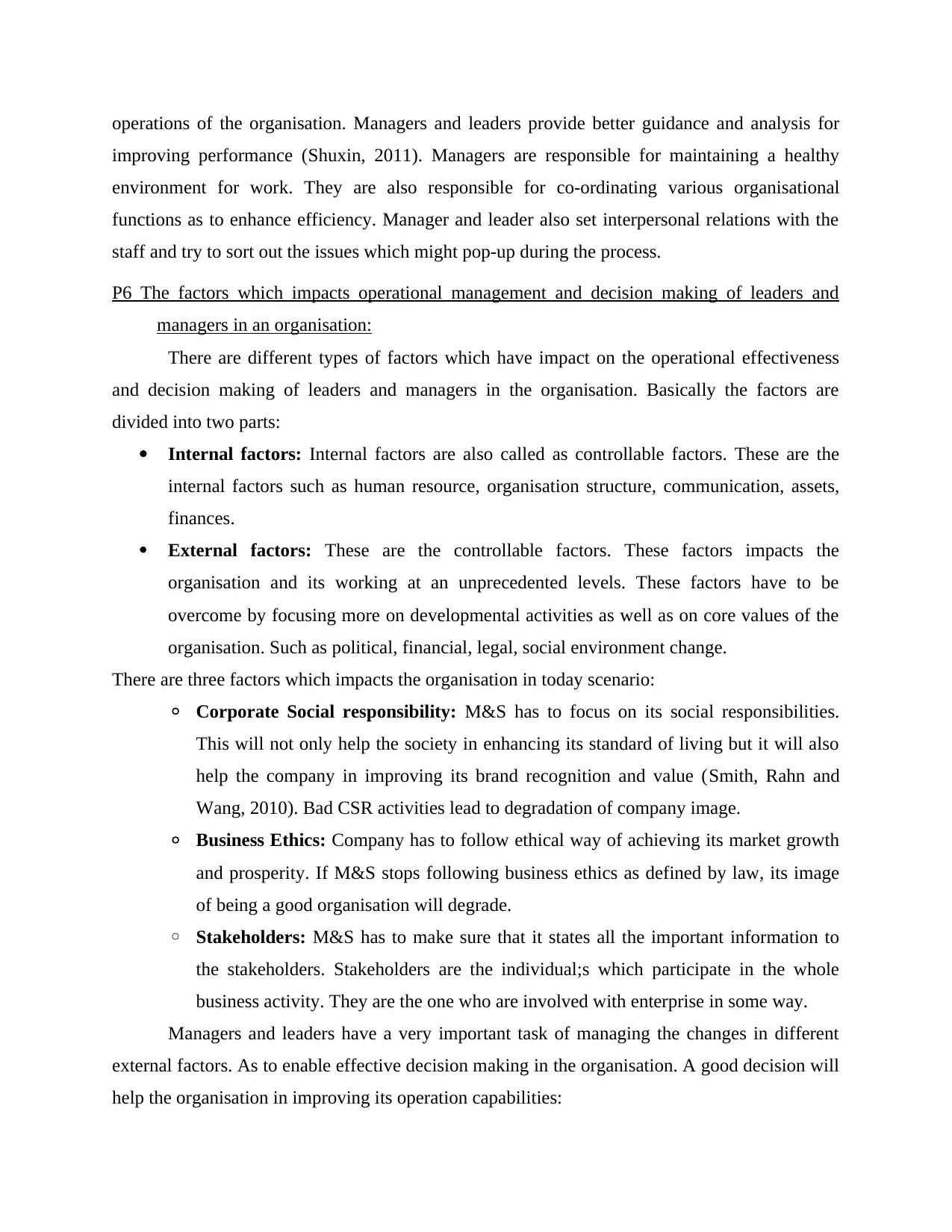
operations of the organisation. Managers and leaders provide better guidance and analysis for
improving performance (Shuxin, 2011). Managers are responsible for maintaining a healthy
environment for work. They are also responsible for co-ordinating various organisational
functions as to enhance efficiency. Manager and leader also set interpersonal relations with the
staff and try to sort out the issues which might pop-up during the process.
P6 The factors which impacts operational management and decision making of leaders and
managers in an organisation:
There are different types of factors which have impact on the operational effectiveness
and decision making of leaders and managers in the organisation. Basically the factors are
divided into two parts:
Internal factors: Internal factors are also called as controllable factors. These are the
internal factors such as human resource, organisation structure, communication, assets,
finances.
External factors: These are the controllable factors. These factors impacts the
organisation and its working at an unprecedented levels. These factors have to be
overcome by focusing more on developmental activities as well as on core values of the
organisation. Such as political, financial, legal, social environment change.
There are three factors which impacts the organisation in today scenario:
◦ Corporate Social responsibility: M&S has to focus on its social responsibilities.
This will not only help the society in enhancing its standard of living but it will also
help the company in improving its brand recognition and value (Smith, Rahn and
Wang, 2010). Bad CSR activities lead to degradation of company image.
◦ Business Ethics: Company has to follow ethical way of achieving its market growth
and prosperity. If M&S stops following business ethics as defined by law, its image
of being a good organisation will degrade.
◦ Stakeholders: M&S has to make sure that it states all the important information to
the stakeholders. Stakeholders are the individual;s which participate in the whole
business activity. They are the one who are involved with enterprise in some way.
Managers and leaders have a very important task of managing the changes in different
external factors. As to enable effective decision making in the organisation. A good decision will
help the organisation in improving its operation capabilities:
improving performance (Shuxin, 2011). Managers are responsible for maintaining a healthy
environment for work. They are also responsible for co-ordinating various organisational
functions as to enhance efficiency. Manager and leader also set interpersonal relations with the
staff and try to sort out the issues which might pop-up during the process.
P6 The factors which impacts operational management and decision making of leaders and
managers in an organisation:
There are different types of factors which have impact on the operational effectiveness
and decision making of leaders and managers in the organisation. Basically the factors are
divided into two parts:
Internal factors: Internal factors are also called as controllable factors. These are the
internal factors such as human resource, organisation structure, communication, assets,
finances.
External factors: These are the controllable factors. These factors impacts the
organisation and its working at an unprecedented levels. These factors have to be
overcome by focusing more on developmental activities as well as on core values of the
organisation. Such as political, financial, legal, social environment change.
There are three factors which impacts the organisation in today scenario:
◦ Corporate Social responsibility: M&S has to focus on its social responsibilities.
This will not only help the society in enhancing its standard of living but it will also
help the company in improving its brand recognition and value (Smith, Rahn and
Wang, 2010). Bad CSR activities lead to degradation of company image.
◦ Business Ethics: Company has to follow ethical way of achieving its market growth
and prosperity. If M&S stops following business ethics as defined by law, its image
of being a good organisation will degrade.
◦ Stakeholders: M&S has to make sure that it states all the important information to
the stakeholders. Stakeholders are the individual;s which participate in the whole
business activity. They are the one who are involved with enterprise in some way.
Managers and leaders have a very important task of managing the changes in different
external factors. As to enable effective decision making in the organisation. A good decision will
help the organisation in improving its operation capabilities:
Paraphrase This Document
Need a fresh take? Get an instant paraphrase of this document with our AI Paraphraser
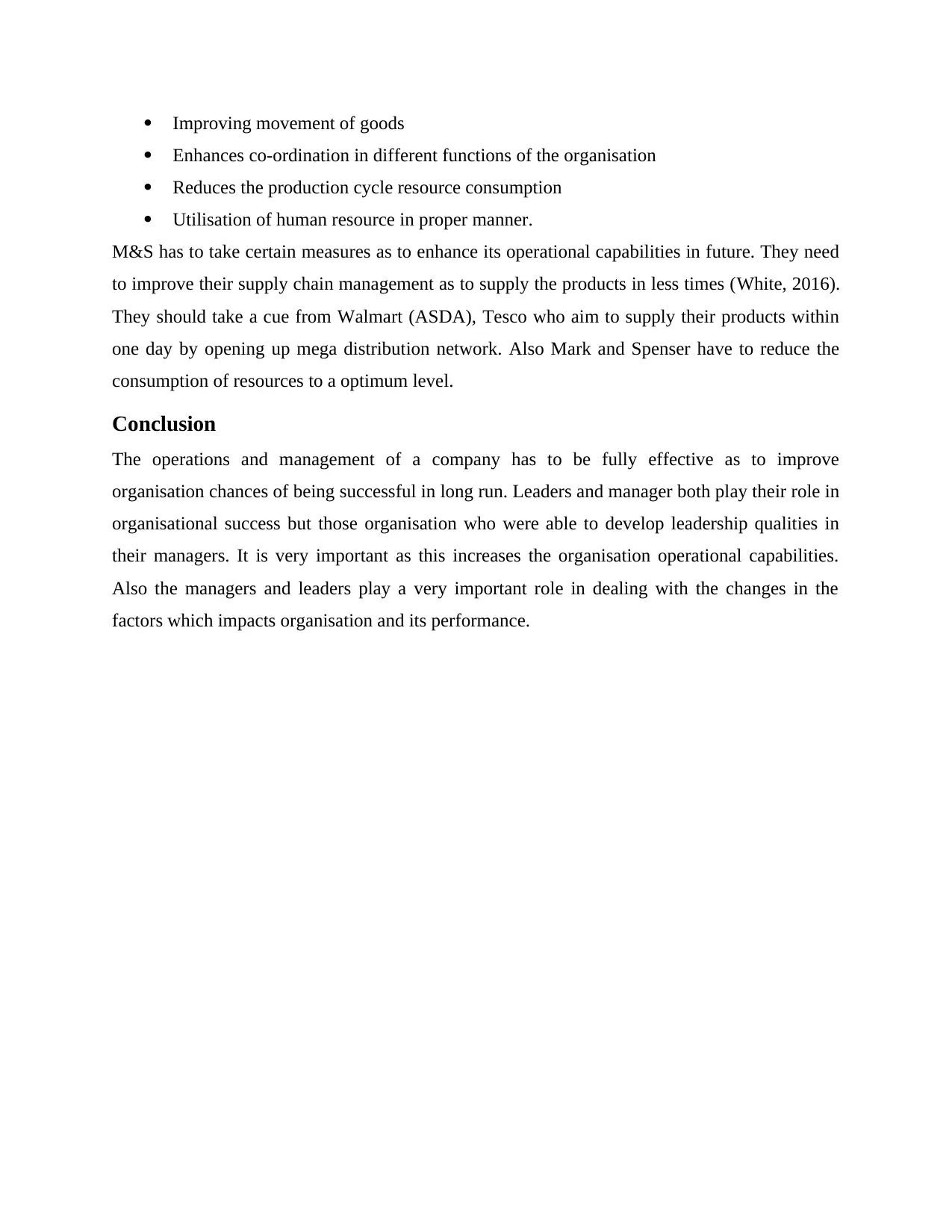
Improving movement of goods
Enhances co-ordination in different functions of the organisation
Reduces the production cycle resource consumption
Utilisation of human resource in proper manner.
M&S has to take certain measures as to enhance its operational capabilities in future. They need
to improve their supply chain management as to supply the products in less times (White, 2016).
They should take a cue from Walmart (ASDA), Tesco who aim to supply their products within
one day by opening up mega distribution network. Also Mark and Spenser have to reduce the
consumption of resources to a optimum level.
Conclusion
The operations and management of a company has to be fully effective as to improve
organisation chances of being successful in long run. Leaders and manager both play their role in
organisational success but those organisation who were able to develop leadership qualities in
their managers. It is very important as this increases the organisation operational capabilities.
Also the managers and leaders play a very important role in dealing with the changes in the
factors which impacts organisation and its performance.
Enhances co-ordination in different functions of the organisation
Reduces the production cycle resource consumption
Utilisation of human resource in proper manner.
M&S has to take certain measures as to enhance its operational capabilities in future. They need
to improve their supply chain management as to supply the products in less times (White, 2016).
They should take a cue from Walmart (ASDA), Tesco who aim to supply their products within
one day by opening up mega distribution network. Also Mark and Spenser have to reduce the
consumption of resources to a optimum level.
Conclusion
The operations and management of a company has to be fully effective as to improve
organisation chances of being successful in long run. Leaders and manager both play their role in
organisational success but those organisation who were able to develop leadership qualities in
their managers. It is very important as this increases the organisation operational capabilities.
Also the managers and leaders play a very important role in dealing with the changes in the
factors which impacts organisation and its performance.
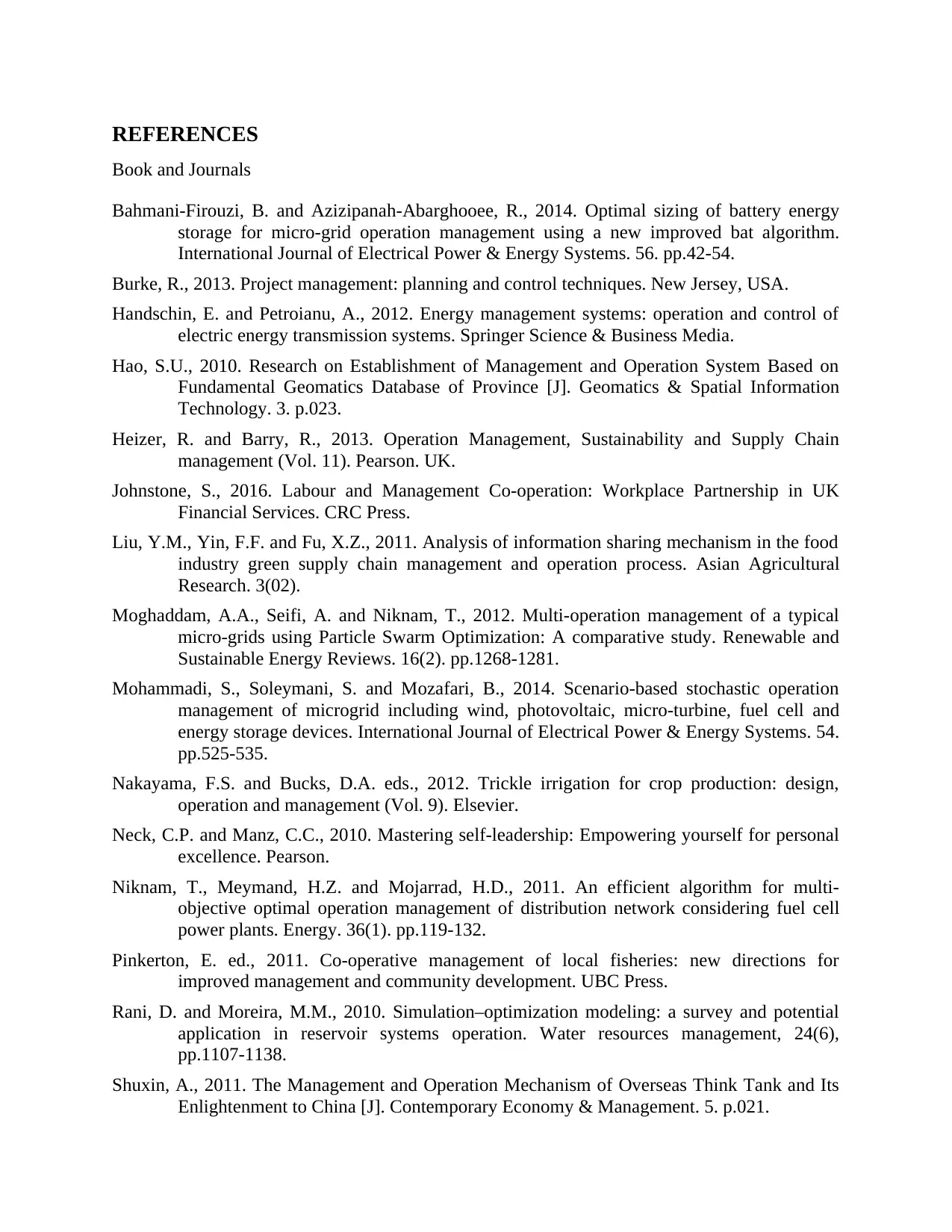
REFERENCES
Book and Journals
Bahmani-Firouzi, B. and Azizipanah-Abarghooee, R., 2014. Optimal sizing of battery energy
storage for micro-grid operation management using a new improved bat algorithm.
International Journal of Electrical Power & Energy Systems. 56. pp.42-54.
Burke, R., 2013. Project management: planning and control techniques. New Jersey, USA.
Handschin, E. and Petroianu, A., 2012. Energy management systems: operation and control of
electric energy transmission systems. Springer Science & Business Media.
Hao, S.U., 2010. Research on Establishment of Management and Operation System Based on
Fundamental Geomatics Database of Province [J]. Geomatics & Spatial Information
Technology. 3. p.023.
Heizer, R. and Barry, R., 2013. Operation Management, Sustainability and Supply Chain
management (Vol. 11). Pearson. UK.
Johnstone, S., 2016. Labour and Management Co-operation: Workplace Partnership in UK
Financial Services. CRC Press.
Liu, Y.M., Yin, F.F. and Fu, X.Z., 2011. Analysis of information sharing mechanism in the food
industry green supply chain management and operation process. Asian Agricultural
Research. 3(02).
Moghaddam, A.A., Seifi, A. and Niknam, T., 2012. Multi-operation management of a typical
micro-grids using Particle Swarm Optimization: A comparative study. Renewable and
Sustainable Energy Reviews. 16(2). pp.1268-1281.
Mohammadi, S., Soleymani, S. and Mozafari, B., 2014. Scenario-based stochastic operation
management of microgrid including wind, photovoltaic, micro-turbine, fuel cell and
energy storage devices. International Journal of Electrical Power & Energy Systems. 54.
pp.525-535.
Nakayama, F.S. and Bucks, D.A. eds., 2012. Trickle irrigation for crop production: design,
operation and management (Vol. 9). Elsevier.
Neck, C.P. and Manz, C.C., 2010. Mastering self-leadership: Empowering yourself for personal
excellence. Pearson.
Niknam, T., Meymand, H.Z. and Mojarrad, H.D., 2011. An efficient algorithm for multi-
objective optimal operation management of distribution network considering fuel cell
power plants. Energy. 36(1). pp.119-132.
Pinkerton, E. ed., 2011. Co-operative management of local fisheries: new directions for
improved management and community development. UBC Press.
Rani, D. and Moreira, M.M., 2010. Simulation–optimization modeling: a survey and potential
application in reservoir systems operation. Water resources management, 24(6),
pp.1107-1138.
Shuxin, A., 2011. The Management and Operation Mechanism of Overseas Think Tank and Its
Enlightenment to China [J]. Contemporary Economy & Management. 5. p.021.
Book and Journals
Bahmani-Firouzi, B. and Azizipanah-Abarghooee, R., 2014. Optimal sizing of battery energy
storage for micro-grid operation management using a new improved bat algorithm.
International Journal of Electrical Power & Energy Systems. 56. pp.42-54.
Burke, R., 2013. Project management: planning and control techniques. New Jersey, USA.
Handschin, E. and Petroianu, A., 2012. Energy management systems: operation and control of
electric energy transmission systems. Springer Science & Business Media.
Hao, S.U., 2010. Research on Establishment of Management and Operation System Based on
Fundamental Geomatics Database of Province [J]. Geomatics & Spatial Information
Technology. 3. p.023.
Heizer, R. and Barry, R., 2013. Operation Management, Sustainability and Supply Chain
management (Vol. 11). Pearson. UK.
Johnstone, S., 2016. Labour and Management Co-operation: Workplace Partnership in UK
Financial Services. CRC Press.
Liu, Y.M., Yin, F.F. and Fu, X.Z., 2011. Analysis of information sharing mechanism in the food
industry green supply chain management and operation process. Asian Agricultural
Research. 3(02).
Moghaddam, A.A., Seifi, A. and Niknam, T., 2012. Multi-operation management of a typical
micro-grids using Particle Swarm Optimization: A comparative study. Renewable and
Sustainable Energy Reviews. 16(2). pp.1268-1281.
Mohammadi, S., Soleymani, S. and Mozafari, B., 2014. Scenario-based stochastic operation
management of microgrid including wind, photovoltaic, micro-turbine, fuel cell and
energy storage devices. International Journal of Electrical Power & Energy Systems. 54.
pp.525-535.
Nakayama, F.S. and Bucks, D.A. eds., 2012. Trickle irrigation for crop production: design,
operation and management (Vol. 9). Elsevier.
Neck, C.P. and Manz, C.C., 2010. Mastering self-leadership: Empowering yourself for personal
excellence. Pearson.
Niknam, T., Meymand, H.Z. and Mojarrad, H.D., 2011. An efficient algorithm for multi-
objective optimal operation management of distribution network considering fuel cell
power plants. Energy. 36(1). pp.119-132.
Pinkerton, E. ed., 2011. Co-operative management of local fisheries: new directions for
improved management and community development. UBC Press.
Rani, D. and Moreira, M.M., 2010. Simulation–optimization modeling: a survey and potential
application in reservoir systems operation. Water resources management, 24(6),
pp.1107-1138.
Shuxin, A., 2011. The Management and Operation Mechanism of Overseas Think Tank and Its
Enlightenment to China [J]. Contemporary Economy & Management. 5. p.021.
⊘ This is a preview!⊘
Do you want full access?
Subscribe today to unlock all pages.

Trusted by 1+ million students worldwide
1 out of 14
Related Documents
Your All-in-One AI-Powered Toolkit for Academic Success.
+13062052269
info@desklib.com
Available 24*7 on WhatsApp / Email
![[object Object]](/_next/static/media/star-bottom.7253800d.svg)
Unlock your academic potential
Copyright © 2020–2025 A2Z Services. All Rights Reserved. Developed and managed by ZUCOL.





